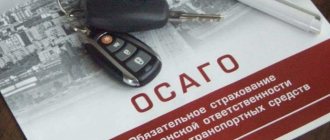Having an MTPL insurance policy guarantees that damage caused to other persons as a result of an accident will be compensated. Despite this, every driver should know what OSAGO covers in case of an accident, as well as the amount of compensation that you can count on. Receiving an insurance payment is always associated with a certain number of features and conditions, which insurance companies often use to reduce the amount of payments.
Enshrining the provisions on compulsory motor liability insurance in law is not yet an absolute guarantee of receiving payment. There are many nuances that directly affect the determination of the amount of payment, as well as its provision.
Characteristics of the insurance policy
Having an MTPL policy is mandatory for every driver. Insurance is issued for a period of no more than a year and requires constant renewal. An insurance policy is issued for a specific car, and specific drivers are included in it. Insurance rules apply only to legal users, so having an invalid MTPL policy does not protect the driver. There is also open insurance, which allows any number of drivers to drive.
If there is no policy or if it is invalid, the driver will not be able to register the car with the state. In addition, the department in this case is punished with fines of up to 800 rubles. The most significant consequence is the lack of insurance for your civil liability on the road. This means that the driver will be responsible for all and any damage caused.
IMPORTANT !!! An issued policy guarantees that in the event of an insured event, the damage will be compensated at the expense of the insurance company. The main nuances of receiving payments are related to insurance cases, which are subject to strict requirements. Therefore, it is not always possible to obtain compensation from the insurance company.
Today, compensation can occur in two ways: repairing the damaged car, or paying a sum of money. The first option always has priority, but in certain cases a payment is made. This rule was established in 2021 to reduce the number of cases of insurance fraud, but for ordinary drivers such changes cannot be called positive.
What if I have Casco?
And here everything is simple. You can simply apply under the Casco agreement and receive full compensation, regardless of your fault for the accident. This, of course, depends on the terms of such an agreement, but they almost never establish such restrictions as a mutual accident.
After applying, your Casco insurer will recover damages from the insurance company of the second party to the accident instead of you, but in the same way as you would have recovered - in the same proportion as the degree of guilt established for the second culprit.
Insurance cases
Compensation for damage occurs only upon the occurrence of an insured event. In any other situations, the insurance company has the right to refuse to fulfill obligations.
If we generalize all situations, we can give the following definition of an insured event. An insured event is the emergence of grounds for civil liability in the event of damage to property, life and health of people. The MTPL policy covers only the damage that was caused in a traffic accident. The occurrence of an insured event is the basis for providing compensation to the victims.
However, not any harm can be regarded as an insured event.
The law establishes that compensation under the compulsory motor liability insurance policy is not made in the following situations:
- driving the car was illegal (the driver was not included in the insurance policy);
- for causing moral damage, as well as for lost profits of the victim;
- if the harm was caused as part of educational, extreme or professional driving;
- the accident causes significant harm to the environment;
- the damage was caused as a result of the impact of the cargo transported on the vehicle;
- if the victim has a special type of insurance. For example, social, labor. In this case, payment occurs according to special rules;
- if damage was caused to your car, or to yourself as a result of mistakes made;
- As a result of the accident, rare cultural, religious and other values were damaged;
- the amount of damage caused is above the established limit. In this case, a judicial penalty occurs from the person found guilty.
ATTENTION !!! From the above it is clear that not in all cases the driver will be able to count on receiving insurance compensation for causing harm.
In practice, there are often controversial situations in which it is difficult to determine whether an insured event has occurred. If the driver and other third parties are interested, they can file a claim with the insurance company, and if the claim is refused, file a claim in court.
What is considered harm
Any insurance payment provides compensation for damage caused.
Regarding compulsory motor liability insurance, harm may be as follows:
- property, when cars and any other things are damaged, including persons not directly involved in the accident;
- harm to people's health. Any person injured in a specific accident can count on compensation for damage caused.
However, not all harm will be compensated. The category of property damage includes the so-called lost profits, when, due to an accident, a person was unable to receive benefits in the future or lost them. For example, a bus ticket was expired due to an accident. The insurance company is not obligated to compensate for such losses.
IMPORTANT !!! Moral damage, which is not subject to compensation under the compulsory motor liability insurance policy, should be distinguished from personal injury. Moral damage is any moral and physical suffering that a person received as a result of an accident. Almost any adverse consequences can fall under the category of moral damage. For example, pain arising from injury, or increased nervousness, insomnia. A prerequisite is that these consequences arise precisely because of an accident.
The insurance company will not make payments for either lost profits or moral damages. For both types of liability, the person responsible for the accident is fully responsible. To do this, the victim must file a claim with evidence and indicate the amount of harm caused. Based on all objective circumstances, the court will decide on the award of compensation.
What to do if a mutual accident occurs?
Of course, formalize it. The procedure here is exactly the same as in any other accident, as prescribed by paragraphs 2.5-2.6.1 of the traffic rules:
- stop the vehicles immediately and do not move them,
- put up an emergency sign and turn on the emergency lights,
- call the traffic police (if there are injured/dead or there is no opportunity or desire to draw up a European protocol).
But many car owners may have questions regarding further actions. Although in this case there is nothing special. So, let's find out the further procedure in case of mutual fault in the incident.
Important note!
- This article describes the basic principles of how legislation works. Meanwhile, in judicial practice everything depends on specific circumstances.
- In 96% of all cases there are subtleties that can affect the outcome of the entire case.
- Therefore, we recommend entrusting the matter to professionals who will study your business and select the right winning strategy.
The TonkostiDTP website employs professional road accident lawyers with experience in all major types of disputes (MTPL, guilt, administrative penalties).
Ask a lawyer
or get a free consultation by calling the hotline: 8.
Which insurance company should I contact?
In its own way, if the conditions for this prescribed by Article 14.1 of the Federal Law on Compulsory Motor Liability Insurance are met:
- Only cars were damaged
- all participants have valid MTPL policies,
- in an accident there was interaction (direct collision, not non-contact) of cars.
Thus, it does not matter whether the accident was mutually blamed or whether the culprit is one participant. The rules for direct claims are not affected by this and, if the conditions for this are met, you must contact your insurance company.
Please note that if the above criteria are met, you do not have the right to choose where to go for payment, but the obligation to go only to your insurer. And vice versa, if at least one of the criteria is not met (for example, you do not have compulsory motor insurance or there was a non-contact accident), then only contact the insurer of the other participant.
Will I be paid or sent for repairs?
The form of compensation for damages also does not depend on liability and fault. In case of a mutual accident, the same rules apply: by default, the insurer is obliged to issue a referral for repairs, and payment is due if the conditions from clause 16.1 of Article 12 of the Federal Law 40 are met:
- in the accident there were victims with moderate or severe harm to health or deaths,
- there was a total loss of the car,
- if the victim is disabled,
- if, according to the calculation, the amount of damage exceeded the maximum limit in compulsory motor liability insurance,
- if the victim and the insurance company have entered into a payment agreement by mutual consent,
- and also if the insurer does not have car services that meet the requirements of the law (in the same article 12).
Will I have to pay extra?
We found out that even if you were both at fault in an accident, you may be sent for repairs. But what if the amount of compensation is not full? Is it really possible that the car will only be repaired halfway?!
Not at all! But the insurer is not obliged to pay extra from its own funds. In this case, the service station will either completely restore your car for your additional payment, or there will be a cash payment. That is, you have the right to pay extra for a complete repair - it is a right, not an obligation. This is what subparagraph “d” of paragraph 16.1 of Article 12 of the Federal Law on Compulsory Motor Liability Insurance tells us.
Thus, in case of a rim accident, you can choose:
- payment in money
- or pay extra and your car will be completely repaired.
But for obvious reasons, the law does not provide for partial restoration of the car.
How do I know if I have been paid enough?
So, you filed a claim with the insurer, and as a result, you were paid a certain amount of money. But how can you understand that everything was calculated correctly for you and that you weren’t deceived by not paying extra? After all, you already know that the amount of damage will be reduced by the share of guilt. But we didn’t see any specific amounts.
So see them! The fact is that clause 4.23 of the Insurance Rules obliges the insurance company to familiarize you with the results of the calculation, issuing a copy of the report upon its readiness within 3 days from the date of your written request.
And it is in the act that you will see both the full amount of damage without deducting interest, and after deduction, and you will be able to understand whether the insurance company has underestimated the payment.
Amount of insurance payment
When an insured event is established, the organization is obliged to make payments to the injured party. However, the maximum amount under the MTPL policy is limited by law and in 2021 is no more than 400 thousand rubles for damage caused to property and 500 thousand rubles for damage to life and health. These amounts are the maximum permissible, beyond which all payments fall on the culprit of the accident (however, there are exceptions to this rule).
The insurance company must determine the amount of payment. For this purpose, examinations are appointed and calculations are carried out. Based on all the data received, a decision is made to pay compensation in a certain amount. In the case of a car, it is possible to provide repairs for a set amount. Very often, insurance companies try to reduce the amount of payments as much as possible. If interested parties disagree, the decision can be appealed in court.
Regulations
Compulsory car insurance is regulated by several documents, but the main ones are:
- Federal Law “On Compulsory Motor Liability Insurance”,
- OSAGO rules.
The Rules contain the main provisions of the Law in a condensed form, some of which are:
- conditions and procedure for compulsory motor liability insurance;
- maximum maximum amounts of compensation in the event of a traffic accident;
- procedure for issuing and canceling a policy;
- rights and obligations of insurers and injured parties at the time of the occurrence of an insured event;
- rules for calculating the amount of compensation and the period during which the insurance company must pay the due amount or refuse for a good reason;
- rights of the Russian Union of Auto Insurers;
- sequence of actions to obtain compensation in the event of bankruptcy of the insurer.
Types of compensation under OSAGO
The insurance company has the right to provide compensation in the form of property repairs, or by providing payment for independent use. If the damage was caused solely to the car, in most cases the insurance company will offer to carry out repairs at its expense.
Most drivers do not like this option due to the large number of features. There is a rule according to which you cannot install a worn-out part, so be sure to purchase new spare parts. For some cars, this can cost more than half the cost of the vehicle itself (especially true for older cars). In addition, you will not be able to choose a service yourself and repairs will be carried out at service stations offered by the insurer.
Despite this, there are situations when compensation must be in cash:
- the car cannot be repaired, or it is as unprofitable as possible. Such an opinion must be given by experts, and the decision is made by the insurance company itself;
- it is impossible to carry out repairs in the established amount, and the driver refuses to pay on his own;
- in case of failure of the insurance company to fulfill its obligation to make repairs within the prescribed period, or when it is impossible to carry out repairs;
- upon reaching an agreement between the parties, if the insurance company is ready to accommodate the victim. This usually happens when the victim’s financial situation is difficult;
- if people died as a result of an accident. Relatives of the deceased have the right to receive payment from the insurance company.
In the latter case, as well as in the case of harm to the passenger, an explanation was given by the RF Armed Forces, which should be considered separately.
Who is obligated to pay extra for repairs?
A popular option: the car is brought to a service station, the amount of repairs exceeds the insurance payment, representatives of the workshop demand that the owner of the vehicle pay the difference. Of course, the subject can do this if he does not want to waste time. But such demands are absolutely illegal. If the subject, that is, the insured person, is not at fault for the accident, then he should not bear the costs of restoring the car.
If there are still not enough funds, then further actions depend on the situation: it is not enough due to an underestimation of the amount by the insurance company or due to exceeding the limit. If the actual amount of repair and restoration work is more than 400 thousand rubles, then you need to submit a claim for payment to the person at fault for the accident. How to do this will be discussed further. If, according to your calculations, the amount is deliberately underestimated by the insurer, then a claim is submitted to the company.
For example, the requirement for compensation for damage on the part of the culprit is also regulated by civil law. Therefore, if you refuse to pay, you can go to court.
Receiving compensation
Any person who suffered damage as a result of an incident can receive insurance compensation. In this case, it does not matter whether they have a valid MTPL policy, since all payments are made by the insurance company of the guilty party.
ATTENTION !!! The obtaining procedure is quite simple, but has some features. It consists of preparing and submitting all necessary documents to the insurer, who reviews and makes a decision within the period established by law. If the interested party disagrees with the decision, it can be appealed in court.
The payment made in favor of the injured passenger has a certain feature. In this regard, an explanation was given by the RF Armed Forces, according to which two insurance companies must compensate for the damage at once. It does not matter which party was at fault for the accident. The claim is filed both by the person at fault for the accident and by all other participants.
If the accident results in death, the right to receive compensation passes to the relatives of the deceased. They make demands on each participant in the accident, as a result of which the total amount of payments can be increased by 2 or more times. Despite the maximum amount under compulsory motor liability insurance of 500 thousand, each insurer will only be able to receive 475 thousand rubles. This is due to the mandatory payment for the funeral, which amounts to 25 thousand rubles. Since this type of damage is material, it will be paid jointly.
Who pays in the case of a “reciprocity”?
Now let’s find out exactly how payments are distributed when all drivers involved in an accident are mutually responsible.
What if both drivers have MTPL insurance?
So, in this situation, both drivers will receive insurance compensation. But what will the calculation be and which insurer will pay compensation?
Everything is very simple. Paragraph 22 of Article 12 of the Law on Compulsory Motor Liability Insurance establishes that in this case the payment will be either in equal shares according to the number of participants, or in inverse proportion to the degree of guilt of each of them.
Again, this statement requires some explanation.
- In the event that an accident was registered using a European protocol or by traffic police officers, and the drivers agreed with this, no one went anywhere further to appeal or establish the degree of guilt, then the insurance companies of both participants will pay the victims in equal shares according to the number of these same participants. For example, if 2 cars are involved in an accident, then both of their owners will receive half the calculated damage to their cars. If 3, then 1/3 of the full refund.
- However, if the guilt in a given incident was determined by a court decision, then it, as a rule, also establishes the degree of guilt of each driver. And in this case, each victim receives compensation to the extent that he is not guilty.
In exactly the same way, the provisions of this provision in Article 12 are explained in the judicial practice of the Supreme Court in paragraph 46 of the Resolution of the Plenum No. 58.
For example, one of the drivers did not give way when leaving the adjacent territory, and the other was driving in reverse in violation of traffic rules. The traffic police inspectors arrived and issued both warrants for violations. Moreover, if both of them had not applied to the court for a decision to establish the degree of guilt, then they would have been paid 50% of the damage. But one of the drivers filed a lawsuit, which considered that the one who did not give way was 70% at fault, and the one driving in reverse – 30%. And then the insurance compensation will be calculated as follows:
- Let’s say the damage to a car that did not give way is calculated at 100,000 rubles, in this case he will receive only 30,000 rubles, since he is 70% at fault - that is, the percentage of guilt is deducted from the amount of damage,
- and the damage to the car moving backwards is determined to be 40,000 rubles, and he receives 28,000 rubles (40,000 minus 30% of his degree of guilt in this mutual accident).
However, there is an important subtlety here when the blame in court can fall entirely on the one who was moving in reverse - we will discuss this topic below when describing the procedure for appealing a “reversal”.
If one of the participants in the accident does not have a policy?
Everything is simple here too. Anyone who did not have MTPL insurance applies for damages to the insurance company of the second participant. And the one who has the policy applies directly to the causer of harm, since the latter does not have liability insurance.
But even in the absence of insurance, liability is subject to compensation, inversely proportional to the degree of guilt. That is, here everything works exactly the same as in the example above, only this percentage is reimbursed not by the insurer if the participant does not have a compulsory motor liability insurance policy, but by the tortfeasor himself from his own pocket.
Procedure for contacting an insurance company
There is a recommendation according to which documents must be submitted within the first 5 days from the date of the accident. This is not mandatory and there are no penalties for violating the deadline. It is also impossible to refuse compensation if the documents were submitted later.
The claim is made to the insurance company of the person responsible for the accident, regardless of the circumstances.
The following package of documents must be attached to the application:
- identification;
- a document confirming the fact of the accident. If the registration was carried out by a traffic police officer - a certificate issued, if independently - a European protocol;
- documents for the car, registration certificate;
- bank details to which the compensation amount should be transferred.
IMPORTANT !!! Since the law does not establish special deadlines for receiving payment of compensation, general civil deadlines are applied to insurance legal relations. You can submit documents no later than 3 years. However, in exceptional cases the period may be extended.
The insurance company may refuse to provide compensation or significantly reduce the amount of payment. In practice, such decisions are made quite often. If you disagree with the decision, as well as if there is evidence, a judicial appeal is possible. However, you should first try pre-trial proceedings and present a claim to the insurance company. Since insurance disputes are a complex procedure, it will be problematic to understand all the nuances on your own. To increase the chances of a positive resolution, you should seek legal assistance from specialists.











